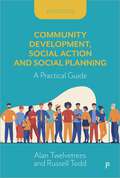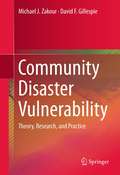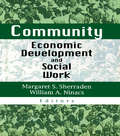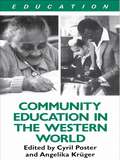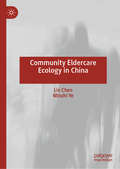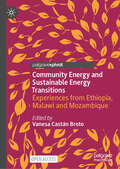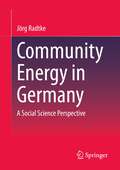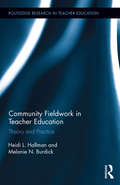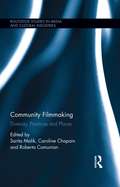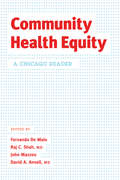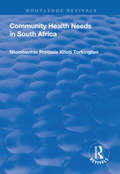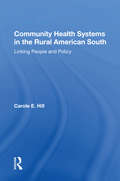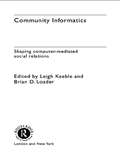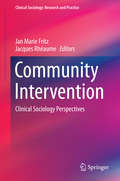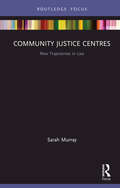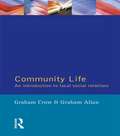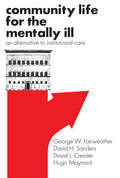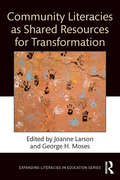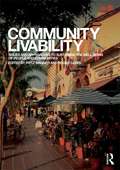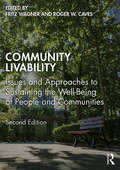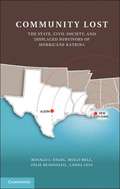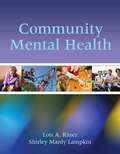- Table View
- List View
Community Development, Social Action and Social Planning 6e: A Practical Guide
by Alan Twelvetrees Russell ToddThe sixth, fully updated edition of this bestselling guide links the theory and practice of community work in an insightful and relatable read for students and practitioners alike. With an accessible style, experienced author Alan Twelvetrees sets out the realities of practice in everyday community development (CD) work. With a much-expanded section on specialist community work, the guide also features brand new sections on work in health, housing, with children, young people and those with disabilities and the changing role of IT, particularly since the COVID-19 pandemic. This edition features: • clear ‘how to’ guides for a variety of CD-related practice; • case studies; • end of chapter discussion points; • signposts to digital resources; • glossary. This classic text provides a comprehensive overview of the knowledge required to work in community practice in the UK and is essential for anyone studying or working in the field.
Community Disaster Vulnerability: Theory, Research, and Practice
by David F. Gillespie Michael J. ZakourDisaster vulnerability is rapidly increasing on a global scale, particularly for those populations which are the historical clients of the social work profession. These populations include the very young and very old, the poor, ethnic and racial minorities, and those with physical or mental disabilities. Social workers are increasingly providing services in disasters during response and recovery periods, and are using community interventions to reduce disaster vulnerability. There is a need for a cogent theory of vulnerability and research that addresses improved community disaster practice and community resilience. Community Disaster Vulnerability and Resilience provides a unifying theoretical framework backed by research which can be translated into knowledge for effective practice in disasters.
Community Economic Development and Social Work
by Margaret S SherradenIn Community Economic Development and Social Work, you’ll find innovative theoretical approaches to the newly emerging field of community economic development (CED). You’ll see how community leaders, residents, community organizations, social workers, city planners, local business owners, bankers, and/or investors can come together to promote successful CED.Community economic development (CED) is a strategy that addresses social and economic development goals, creates jobs, builds assets, and strengthens the social fabric of communities. In Community Economic Development and Social Work, you&’ll learn how to promote community-based organizations that involve residents in articulating goals, policies, and operations and moves them beyond poverty. You’ll also gain valuable insight into: methods of evaluating a variety of CED initiatives in different geographical areas microenterprise development and the experiences of low-income entrepreneurs, including examples from Bangladesh and India and in immigrant and low-income communities in the United States home ownership as a key CED strategy in low-income neighborhoods environmental issues and sustainable CED healthcare and CED--entrepreneurial opportunities and job creation organizations, such as Community Development Corporations, that promote CED practicing CED in marginalized communities strategies for creating jobs, developing structures for savings and investment, creating access to credit, promoting land trusts, financing community infrastructure improvements, providing training and technical assistance, and developing social services Contributors to this groundbreaking volume include internationally known scholars and practitioners who examine community economic development initiatives from a variety of perspectives and locales--CED is one of the few areas of applied social science where diffusion regularly occurs from “less developed” to “developed” countries. The variety of models and case studies in Community Economic Development and Social Work gives you practical ideas for effective economic development--development that empowers residents to break the cycle of poverty and offers hope and opportunity for the future--in low-income and minority communities.
Community Education and the Western World
by Angelika Krüger Cyril PosterFirst published in 1990. Routledge is an imprint of Taylor & Francis, an informa company.
Community Eldercare Ecology in China
by Lin Chen Minzhi YeInformed by the social-ecological framework, this book focuses on the development of Home and Community Based Services (HCBS) in urban China. Bringing a timely discussion around HCBS development in Shanghai, it presents an interplay of formal caregiving relationships, evolving caregiving culture, and the trajectory of long-term care in China. Drawing on surveys, in-depth interviews, and government archives, this book explores the emergence of one of the most developed HCBS programs in Shanghai, its development over the past decade, its administration and services, resource allocation, staff members’ work experiences, older adults’ service experiences, as well as service evaluation and improvements. Offering fresh insight into new forms of caregiving in community settings, and shaping a new discourse on caregiving policy, this book is a key read for both students and practitioners in the fields of long-term care, gerontology, geriatrics, health care, and health policy.
Community Energy and Sustainable Energy Transitions: Experiences from Ethiopia, Malawi and Mozambique
by Vanesa Castán BrotoThis open access book engages with the difficulties of delivering community energy in practice, building on practical experiences in Ethiopia, Malawi, and Mozambique. In these countries, where many people lack access to electricity, community energy is an alternative to advance universal energy access. This book argues that, besides providing access, community energy is essential for achieving justice and resilience in sustainable energy transitions. Community energy combines off-grid infrastructures with innovative forms of governance to incorporate the perspectives of beneficiaries in the generation and distribution of electricity. Community energy has multiple benefits for communities, such as facilitating the adoption of renewable technologies, providing energy access where it is lacking, and building resilience. They also offer societal benefits beyond beneficiary communities, such as providing additional capacity to existing grids, delivering off-grid services where the grid is absent, and bridging on-grid and off-grid systems. Despite its promises, however, the adoption of community energy has been slow. This book presents a feminist-informed perspective on community energy to advance energy justice that puts disadvantaged communities at the centre of sustainable energy transitions. It also explores the room for manoeuvre within existing regulatory systems, supply chains, and delivery systems to facilitate its development. By engaging with existing experiences in community energy, the book demonstrates the potential of communities to gain control over their energy needs and resources and argues for the need to develop a wide range of transdisciplinary skills among policymakers, technicians and communities to deliver a just energy transition.
Community Energy in Germany: A Social Science Perspective
by Jörg RadtkeIn this ground-breaking book, Jörg Radtke offers for the first time within research, a comprehensive insight into the range of organizational structures of community energy projects in Germany and their contribution to the Energiewende. Based on nationwide quantitative survey data and in-depth analyses of selected case studies of solar, wind and geothermal projects, Radtke documents the social structure and motivations of participating citizens. He examines new forms of material participation, community building and co-determination within the mostly volunteer-led community energy projects based on the civic engagement patterns of active “green citizens”. The author identifies a new form of individualistic participation and collective modes of action in line with new types of project-oriented participation between business, politics and civil society within sustainability transformation processes of the early 21st century.
Community Fieldwork in Teacher Education: Theory and Practice (Routledge Research in Teacher Education)
by Heidi L Hallman Melanie BurdickIn teacher education, field work in community-based spaces (including foster homes and programs for homeless youth) is frequently contrasted with "traditional" field experiences in classroom settings, where beginning teachers are immediately introduced to teacher-centered models of instruction. This volume works against such a model, presenting a counter-narrative of new teachers’ understanding of the act of teaching. By exploring their work with at risk youth in community-based sites, the authors uncover how non-traditional spaces for teaching and learning have the potential to open new doors for reimagining the teaching act and teacher identity. This volume examines how prospective teachers have used writing within unconventional spaces as catalysts for considering what it means to become a teacher, as well as how the work of teaching can be conceptualized. It unites the practical aspects of field work and with theoretical conceptions of teaching, and envisions how the work and the definition of "teaching" can be broadened.
Community Filmmaking: Diversity, Practices and Places (Routledge Studies in Media and Cultural Industries)
by Sarita Malik Caroline Chapain Roberta ComunianThis book examines the role of community filmmaking in society and its connection with issues of cultural diversity, innovation, policy and practice in various places. Deploying a range of examples from Europe, North America, Australia and Hong Kong, the chapters show that film emerging from outside the mainstream film industries and within community contexts can lead to innovation in terms of both content and processes and a better representation of the cultural diversity of a range of communities and places. The book aims to situate the community filmmaker as the central node in the complex network of relationships between diverse communities, funding bodies, policy and the film industries.
Community Genetics and Genetic Alliances: Eugenics, Carrier Testing, and Networks of Risk (Genetics and Society)
by Aviad E. RazCarrier testing of adults provides information about the risk of passing a genetic mutation to your children, leading to reproductive (and some say, eugenic) decisions. Excessive carrier screening may have adverse effects, but it can also prevent suffering and open up new reproductive options. Raz's study focuses on the interplay of community genetics (the medical organisation of carrier screening) and genetic alliances (networks of individuals at risk), exploring how 'genetic communities' are emerging both within existing ethnic groups and around patients' organizations. While the interplay between carrier testing, reproduction and eugenics has sparked many discussions, this study provides a novel and much-needed perspective on its actual implementation and interpretation by community members. Conflating a cross-cultural spectrum of genetic communities, the benefits and perils of supporting (or restricting) carrier screening are located within broader social issues such as religion, ethnicity, multi-culturalism, abortion, stigmatization, suffering and care-giving. While carrier screening emerges as ultimately a morally justified pronatalist endeavour for the reduction of suffering, thus being different in principle from the 'old' eugenics, it can also carry unintended adverse consequences if left unattended to consumers, communities, or health professionals.
Community Health Equity: A Chicago Reader
by David A. Ansell Fernando De Maio Raj C. Shah John MazzeoPerhaps more than any other American city, Chicago has been a center for the study of both urban history and economic inequity. Community Health Equity assembles a century of research to show the range of effects that Chicago’s structural socioeconomic inequalities have had on patients and medical facilities alike. The work collected here makes clear that when a city is sharply divided by power, wealth, and race, the citizens who most need high-quality health care and social services have the greatest difficulty accessing them. Achieving good health is not simply a matter of making the right choices as an individual, the research demonstrates: it’s the product of large-scale political and economic forces. Understanding these forces, and what we can do to correct them, should be critical not only to doctors but to sociologists and students of the urban environment—and no city offers more inspiring examples for action to overcome social injustice in health than Chicago.
Community Health Needs in South Africa
by Ntombenhle Protasia TorkingtonThis title was first published in 2000: Although the apartheid regime has now been abolished there is still a great deal of work to be done in order to eliminate the disadvantages it created for the health of black people at both micro and macro levels. This book presents the findings of a study commissioned to assess and respond to the health needs of black people in South Africa. The hope expressed by those who participated is that the study is considered within the wider context of understanding the apartheid system and the scars it left behind. Community Health Needs in South Africa represents an excellent example of how action research can be used as a tool to make a difference in people’s lives.
Community Health Systems In The Rural American South: Linking People And Policy
by Carole E HillA cultural perspective of health care systems can provide health care providers and policymakers with a broader understanding of the issues they face when planning and implementing new health programs in communities. Healthcare tales place in a community setting while health care policy is developed at an entirely different level in the larger socioeconomic system. In this study the author attempts to link the community level systems of health with those of the policy level system and allow for a comparison of the convergence and divergence of people's health beliefs and behavior with those of policymakers and of medical anthropology in Coberly.
Community Identity and Political Behavior
by Mary R. AndersonSocial scientists are motivated to understand how various facets of society influence all sorts of behavior. Individual's perceptions about their significance in a given community can have meaningful effects on the way in which we look to communities to develop and foster democratic values and promote civic engagement. The focus of this book is on how community comes to influence political behavior; it takes an interdisciplinary approach blending the fields of community psychology, sociology, and political science. We know from previous research that the context in which an individual interacts influences his/her political behaviors and attitudes. With this in mind, the present research addresses two major questions, 1) how does sense of community influence political behavior and attitudes? and 2) what impact - if any - does involvement in multiple contexts have on political behavior and attitudes?
Community Informatics: Shaping Computer-Mediated Social Networks
by Brian D. Loader Leigh KeebleCommunity groups, social support networks, voluntary agencies and government organisations are all actively exploring the potential of the new information and communication technologies to bring about democratic development and renewal. A rich variety of social experiments in what has become known as Community Informatics is now beginning to provide useful research findings and exciting examples of innovative applications.This book sets down some of the defining features of a Community Informatics approach and some of the common themes which are emerging. In particular it considers the following issues:* sustainability* employment* community management* public service provision* partnerships of stakeholders* local learning* social support and networks.This edited collection brings together leading exponents of Community Informatics from around the world and critically evaluates their experiences.
Community Intervention: Clinical Sociology Perspectives (Clinical Sociology: Research and Practice)
by Jan Marie Fritz Jacques RhéaumeCommunity Intervention: Clinical Sociology Perspectives showcases important efforts to improve the quality of life in communities around the world. The book, a project of the clinical sociology division of the International Sociological Association, describes the interdisciplinary field of clinical sociology in relation to community improvement. The first part of the book covers important concepts and tools for community intervention and identifies a variety of approaches to community research with an emphasis on research that centrally involves community members. The chapters in the second part of the volume focus on projects in a broad range of countries, covering topics such as involving residents in urban renewal projects, developing healthy communities, encouraging socioeconomic development, improving the life of immigrants, helping communities deal with climate change, establishing human rights cities, encouraging empowerment and creating an inclusive community. A unique feature of the book is the inclusion of profiles about some of the outstanding work in community intervention over the last 100 years. These profiles are of Nobel Peace Prize winner Jane Addams; community activist Saul Alinsky; human rights and environmental activist Wangari Maathai and participatory action research pioneer Orlando Fals Borda. Written by scholar-practitioners as well as analysts, the book provides essential commentary regarding community intervention efforts.
Community Justice Centres: New Trajectories in Law (New Trajectories in Law)
by Sarah MurrayThis book examines the phenomenon of Community Justice Centres and their potential to transform the justice landscape by tackling the underlying causes of crime. Marred by recidivism, addiction, family violence, overflowing courtrooms, crippling prison spending and extreme rates of incarceration, the criminal justice system is in crisis. Community Justice Centres seek to combat this by tackling the underlying causes of crime in a particular neighbourhood and working with local people to redesign the experience of justice and enhance the notion of community. A Community Justice Centre houses a court which works with an interdisciplinary team to address the causes of criminality such as drug addiction, cognitive impairment, mental illness, poverty, abuse and intergenerational trauma. The community thus becomes a key agent of change, partnering with the Centre to tackle local issues and improve safety and community cohesion. This book, based on research into this innovative justice model, examines case studies from around the world, the challenges presented by the model and the potential for bringing its learnings into the mainstream. This book will appeal to academics in law and criminology as well as psychology; it will also be of considerable interest to people working in the criminal justice system, including the police, government policy advisers, psychologists and social workers.
Community Life
by Graham Crow Graham AllanFirst published in 1994. Routledge is an imprint of Taylor & Francis, an informa company.
Community Life for the Mentally Ill: An Alternative to Institutional Care
by George W. Fairweather David H. Sanders David L. Cressler Hugo Maynard"Community Life for the Mentally Ill" presents a social innovative experiment aimed at providing new and more participating social positions in American society for mental patients. It presents the events that occurred when a courageous group of former chronic mental patients abruptly left a hospital and established their own autonomous sub-society in a large, metropolitan area.In order to complete this experiment, the patients created a small society in the community where discharged patients could live and work. Others evaluated the effects of the newly created society upon the behavior and perceptions of its members, which is also presented here. Both the descriptive and comparative aspects of this study are presented as they occurred in real life. The book is concerned with the medical, economic, sociological, and psychological facets of these former patients' daily lives. The effects of this small society upon the neighborhood and city in which it was located, as well as its effects upon professional persons, are richly explored.Clearly defining a radical departure from standard methods for treating the mentally ill, the authors conclude that such an autonomous society can thrive in the appropriate setting; the ex-patient's chances of employment are increased and the chance of recidivism are reduced; the member's self-esteem is enhanced; treatment costs are greatly reduced; the community adjustment of all members is increased, especially among those who have been hospitalized for a long period. With new guidelines for identifying danger zones in urban settings, this becomes a critical work.
Community Literacies as Shared Resources for Transformation (Expanding Literacies in Education)
by Joanne Larson George H. MosesThrough multiple narratives reflecting the complexity of participatory action research partnerships for social justice, this book sheds light on the dialogic spaces that intentionally support community literacies and rhetorical practices for inquiry and change. Applying literacy as social practice, Larson and Moses tell a story of a unique collaboration between community members and university faculty and students, who together transformed an urban corner store into a cornerstone of the community. Building on the emerging field of community literacies, the book captures the group’s active work on the ground and, on another level, how transformation occurred in the dialogic spaces of the research team as it learned to embrace distributed expertise and multiple identities.
Community Livability: Issues and Approaches to Sustaining the Well-Being of People and Communities
by Roger Caves Fritz WagnerWhat is a livable community? How do you design and develop one? What does government at all levels need to do to support and nuture the cause of livable communities? Using a blend of theory and practice, experts in the field look at evidence from international, state and local perspectives to explore what is meant by the term "livable communities". Chapters examine the various influencing factors such as the effect and importance of transportation options/alternatives to the elderly, the significance of walkability as a factor in developing a livable and healthy community, the importance of good open space providing for human activity and health, restorative benefits, the importance of coordinated land use and transportation planning, and the relationship between livability and quality of life. While much of the discussion of this topic is usually theoretical and abstract, Wagner and Caves use case studies from North America, Brazil and the United Kingdom to provide substantive examples of initiatives implemented across the world. This book fills an important gap in the literature on livable communities and at the same time assists policy officials, professionals and academics in their quest to develop livable communities.
Community Livability: Issues and Approaches to Sustaining the Well-Being of People and Communities
by Fritz Wagner Roger W. CavesWhat is a livable community? How do you design and develop one? What does government at all levels need to do to support and nurture the cause of livable communities? Using a blend of theory and practice, the second edition of Community Livability addresses evidence from international, state and local perspectives to explore what is meant by the term "livable communities." The second edition contains new chapters from leading academics and practitioners that examine the various factors that constitute a livable community (e.g., the influence and importance of transportation options/alternatives to the elderly, the importance of walkability as a factor in developing a livable and healthy community, the importance of good open space providing for human activity and health, restorative benefits, etc., the importance of coordinated land use and transportation planning), and the relationship between livability and quality of life. A number of chapters focus on livable communities with case studies from an international perspective in USA, Canada, Australia, Peru, Sweden, South Korea, Japan, and Austria.
Community Lost: The State, Civil Society, and Displaced Survivors of Hurricane Katrina
by Ronald J. Angel Holly Bell Julie Beausoleil Laura LeinNeither government programs nor massive charitable efforts responded adequately to the human crisis that was Hurricane Katrina. In this study, the authors use extensive interviews with Katrina evacuees and reports from service providers to identify what helped or hindered the reestablishment of the lives of hurricane survivors who relocated to Austin, Texas. Drawing on social capital and social network theory, the authors assess the complementary, and often conflicting, roles of FEMA, other governmental agencies, and a range of non-governmental organizations in addressing survivors' short- and longer-term needs. While these organizations came together to assist with immediate emergency needs, even collectively they could not deal with survivors' long-term needs for employment, affordable housing, and personal records necessary to rebuild lives. Community Lost provides empirical evidence that civil society organizations cannot substitute for an efficient and benevolent state, which is necessary for society to function.
Community Mental Health
by Lois A. Ritter Shirley Manly LampkinCommunity Mental Health is unique in that it focuses specifically on mental health at the community level. The authors carefully outline the essential skills that health professionals need in order to identify mental health concerns and develop effective programs for communities encountering symptoms of mental disorders or illness. The text includes up-to-date information about mental health issues across the lifespan, the mental health care system, prominent mental health concerns faced by many communities, as well as information about interventions and model programs. The breadth of topics related to community mental health addressed include: indicators of illness and problems, methods of prevention and promotion, evaluation, and research. Instructor Resources, including PowerPoint Presentations, a TestBank, and an Instructor Manual are available as free downloads.
Community Nutrition Resilience in Greater Miami: Feeding Communities in the Face of Climate Change (Palgrave Studies in Climate Resilient Societies)
by Franziska Alesso-BendischThis book conceptualizes community nutrition resilience as a critical area that is currently lacking the attention it requires from both the public and private sectors. The book spotlights Greater Miami’s resilience efforts, both responding to slowly developing challenges such as immigration, environmental deterioration, and the wealth distribution gap, as well as sudden disasters such as hurricanes or flooding driven by climate change. Drawing on existing literature as well as interviews with professionals working in the field, the author makes recommendations on how to incorporate food systems into urban resilience planning, how to prioritize resilience on urban food agendas, and how to strengthen food system resilience through public, private, and third sector level engagement. She also highlights how the availability of and access to nutritious food impact the health, performance, and well-being of communities in the region, thus making a strong case for the prioritization of this growing issue.
